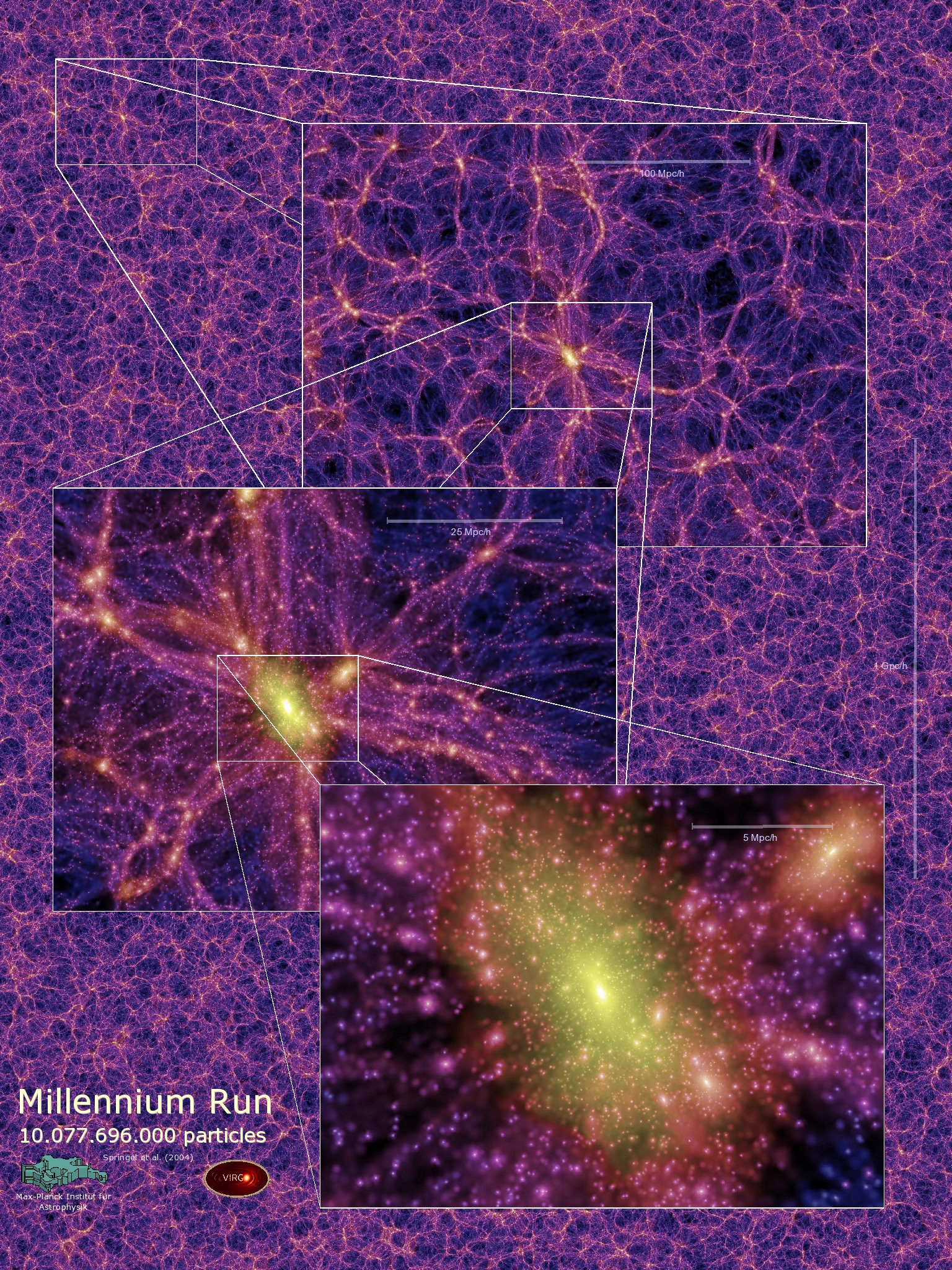nLab structure formation
Contents
Idea
In the context of cosmology, structure formation refers to the process by which cosmological structures such as galaxy clusters and galaxies themselves form under gravitational collapse of a primordial gas.
Various computer simulations (Millennium I, Millennium II, Millennium XXL, Illustris) test theory against observations, such as those by the Planck Collaboration, see Springel 13 for survey.

graphics from The Millennium Simulation Project
Feedback mechanisms and realistic dark matter models
A revolution in realism of computer simulations of galaxy structure formation occurred after ~2010 when hardware and software advances allowed to resolve various feedback mechanisms, such as notably the effect of star-formation inside a gas cloud collapsing to a galaxy. This advance is reflected in the naming of the FIRE-project: Feedback In Realistic Environments.
The resolution of such feedback mechanisms in simulation of galaxy formation seems to resolve long-standing apparent discrepancies of dark matter models with observed galaxy-scale phenomena: For example galactic rotation curves are qualitatively reproduced (Hopkins 17, Figure 4, Figure 5) as is the baryonic Tully-Fisher relation (El-Badry 18, Figure 4).
For more on this see also at dark matter the section On galactic scales.
From Vogelsberger et al. 14:
The simulation reproduces reasonably well the cosmic star formation rate density, the galaxy luminosity function, and baryon conversion efficiency at . It also qualitatively captures the impact of galaxy environment on the red fractions of galaxies. The internal velocity structure of selected well-resolved disk galaxies obeys the stellar and baryonic Tully-Fisher relation together with flat circular velocity curves. In the well-resolved regime the simulation reproduces the observed mix of early-type and late-type galaxies.
See also Illustris Project Website: What are we learning? and Preliminary Results.
Related concepts
References
General
Review includes
-
Joel Primack, Dark Matter and Structure Formation in the Universe, Chapter 1 of Formation of Structure in the Universe, Proceedings of the Jerusalem Winter School 1996, edited by A. Dekel and J.P. Ostriker (arXiv:astro-ph/9707285)
-
Daniel Baumann, The big bang and the origin of structure, 2019 (web)
Galaxy formation:
-
Julio Navarro, Simulations of Galaxy Formation: the State of the Art (pdf)
-
Justin Read et al. EDGE I: the mass-metallicity relation as a critical test of galaxy formation physics (arXiv:1904.02723)
See also
- Wikipedia, Structure formation
Application of persistent homology to cosmological structure formation:
- Matteo Biagetti, Alex Cole, Gary Shiu, The Persistence of Large Scale Structures I: Primordial non-Gaussianity (arXiv:2009.04819)
On structure formation during cosmic inflation via inhomogeneous quantum cosmology:
- Martin Bojowald, Ding Ding, Canonical description of cosmological backreaction, JCAP 03 (2021) 083
Computer simulation
There are various computer simulations for cosmic structure formation, listed below. Review includes the following:
-
Volker Springel, Simulations of Cosmic Structure Formation, USP Cosmology Conference Sao Paulo, February 2013 (pdf, pdf)
-
Kavli Institute for Cosmological Physics, Formation of the large-scale structure in the Universe: simulations
-
Volker Springel, Hydrodynamical galaxy formation simulations, talk, December 2019 (CCA announcement page, video recording)
-
Mark Vogelsberger, Federico Marinacci, Paul Torrey, Ewald Puchwein, Cosmological Simulations of Galaxy Formation, Nature Reviews Physics volume 2, pages 42–66 (2020) (arXiv:1909.07976, doi:10.1038/s42254-019-0127-2)
Millennium Project
- Wikipedia, Millennium Run
Millennium I
Millennium II
- Michael Boylan-Kolchin, Volker Springel, Simon D. M. White, Adrian Jenkins, Gerard Lemson, Resolving Cosmic Structure Formation with the Millennium-II Simulation, Mon.Not.Roy.Astron.Soc.398:1150, 2009 (arXiv:0903.3041)
Millennium XXL
-
The Millennium-XXL Project: Simulating the Galaxy Population of dark Energy Universes (pdf)
-
R. E. Angulo, V. Springel, S. D. M. White, A. Jenkins, C. M. Baugh, C. S. Frenk, Scaling relations for galaxy clusters in the Millennium-XXL simulation, Monthly Notices of the Royal Astronomical Society, Volume 426, Issue 3, 1 November 2012, Pages 2046–2062, (doi:10.1111/j.1365-2966.2012.21830.x, arXiv:1203.3216)
Illustris Project
-
Wikipedia, Illustris project
-
Mark Vogelsberger, Shy Genel, Volker Springel, Paul Torrey, Debora Sijacki, Dandan Xu, Greg Snyder, Dylan Nelson, Lars Hernquist, Introducing the Illustris Project: simulating the coevolution of dark and visible matter in the Universe (arXiv:1405.2921)
FIRE
galaxy formation
-
Shea Garrison-Kimmel, Next-generation Galaxy Formation Simulations with FIRE, 2018 (video recording)
-
Fitts et al. FIRE in the Field: Simulating the Threshold of Galaxy Formation, Mon.Not.Roy.Astron.Soc.471:3547-3562, 2017 (arXiv:1611.02281)
-
Hopkins et al. FIRE-2 Simulations: Physics versus Numerics in Galaxy Formation. Monthly Notices of the Royal Astronomical Society, Volume 480, Issue 1, 11 October 2018, Pages 800–863 (arXiv:1702.06148, doi:10.1093/mnras/sty1690)
-
El-Badry et al. Gas Kinematics in FIRE Simulated Galaxies Compared to Spatially Unresolved HI Observations, Monthly Notices of the Royal Astronomical Society, Volume 477, Issue 2, 21 June 2018, Pages 1536–1548 (arXiv:1801.03933, doi:10.1093/mnras/sty730)
galactic rotation curves qualitatively reproduced in Hopkins 17, Figure 4, Figure 5
baryonic Tully-Fisher relation qualitatively reproduced in El-Badry 18, Figure 4
- Daniel Angles-Alcazar, Multi-scale physical modeling in galaxy formation and evolution, 2019 (web)
VINTERGATAN
Simulation of Milky Way-like galaxies:
Cosmic Dawn
Simulation of galaxy formation in feedback with cosmic reionization:
-
Pierre Ocvirk et al. , Cosmic Dawn (CoDa): the First Radiation-Hydrodynamics Simulation of Reionization and Galaxy Formation in the Local Universe (arXiv:1511.00011)
-
Pierre Ocvirk, et al., Cosmic Dawn II (CoDa II): a new radiation-hydrodynamics simulation of the self-consistent coupling of galaxy formation and reionization (arXiv:1811.11192)
Other
-
The Quijote simulations (arXiv:1909.05273)
-
Tomoaki Ishiyama et al., The Uchuu Simulations: Data Release 1 and Dark Matter Halo Concentrations (arXiv:2007.14720)
Last revised on September 15, 2021 at 04:23:38. See the history of this page for a list of all contributions to it.